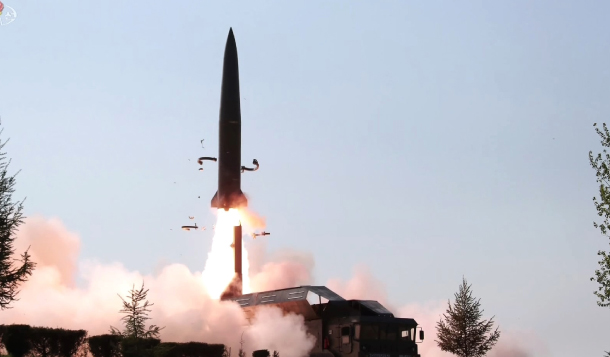Sowing confusion

The author is head of the international, diplomatic and security team at the JoongAng Ilbo.
Looking back, it appears North Korea was out to confuse us from the beginning. First, it resumed missile tests on May 4 after a lull that went on for about a year and a half as it was engaging in summit talks with the United States. But the regime did not test missiles only. It fired a mix of short-range ballistic missiles and rockets from its eastern coast. On the following day, North Korea released photos of what appeared to be a North Korean variation of the 9K720 Iskander short-range ballistic missile and a multiple rocket launcher. The North said the short-range ballistic missile was a “new type of tactical guided weapon.”
North Korea carried out another test on May 9. South Korea’s military said the North test-fired two short-range ballistic missiles. But the following day when North Korean media released photos of the test, it included projectiles, which were presumed to be short-range ballistic missiles, and a range of artillery fired from multiple rocket launchers and self-propelled artillery.
When asked why the South Korean military had not briefed to local media about the other weapons, they said the missile test was conducted at a different location, away from the multiple rocket launchers and self-propelled artillery. That means Pyongyang fired the missiles into the East Sea, whereas rockets and artillery were fired into the Yellow Sea. This was different from the May 4 test, when the North fired both type of weapons into the East Sea.
Then its third test of the year came on July 25, when it fired only short-range ballistic missiles into the East Sea. The Blue House held a National Security Council meeting and said the two projectiles were short-range ballistic missiles. It was the first time this year that the South Korean government officially acknowledged that North Korea fired ballistic missiles, which is strictly banned under United Nations Security Council resolutions. The next day, North Korean media described the missiles as a “new-type tactical guided weapon,” using exactly the same term as its May 4 test, which suggests the missiles it fired on May 4 and July 25 were the same type of missiles.
Then came the fourth test on July 31. But something strange happened. The North tested two projectiles and the South Korean military found them to be short-range ballistic missiles. But the next day, North Korean state media said it had tested multiple rocket launchers and revealed partly pixilated photographs of the weapon. While a multiple rocket launcher simultaneously fires several rockets through cylinder-shaped tubes, ballistic missiles are normally fired one at a time, which is why its launch pad looks different from a multiple rocket launcher. If North Korea was right, it means the South’s military cannot differentiate between a missile and a rocket fired from multiple rocket launchers.

A photo of a new short-range ballistic missile North Korea has test-fired from mobile launchers over the last three months. [YONHAP]
In short, Pyongyang first fired both missiles and rockets at the same time on the same day, then fired them separately on the same day, and then fired only missiles. Then it fired more projectiles into the East Sea, and as the South said they were short-range ballistic missiles, the North contradicted that claim by saying they were actually rocket launches.
Military experts say it has become harder to differentiate between a short-range ballistic missile and a rocket fired from a multiple rocket launcher because the latter has improved in capability. Rockets fired from multiple rocket launchers now travel as fast as ballistic missiles, and some ballistic missiles don’t even follow their flight path in their last phase.
But it’s a huge gap in South Korea’s defense system if our military authorities can’t even tell the difference between a ballistic missile and a rocket fired from a multiple rocket launcher, which can fire hundreds of rockets at once.
On May 4, when the North fired ballistic missiles and rockets at the same time, some analysts already predicted the regime was on to something — that Pyongyang was trying to cause confusion for Seoul and Washington to discern the difference between them and test the detecting abilities of the allies. In a totalitarian regime like North Korea, propaganda is a key means of policy. Not only did Pyongyang test its missile technology, it also succeeded in confusing South Korea and the United States.
JoongAng Ilbo, Aug. 7, Page 27










with the Korea JoongAng Daily
To write comments, please log in to one of the accounts.
Standards Board Policy (0/250자)